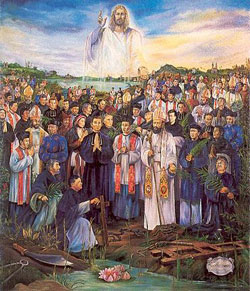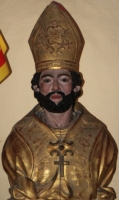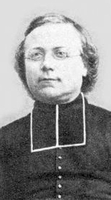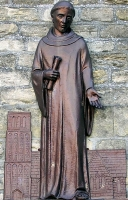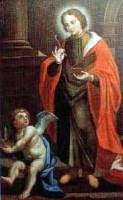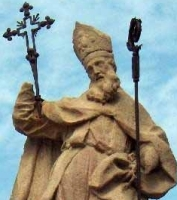St. Matthew Phuong
Feastday: May 26
Death: 1861
Canonized: Pope John Paul II
Martyr of Vietnam. A native, he became a catechist and an ardent Christian. Matthew was arrested by government officials for his faith. He was tortured and then beheaded. Pope John Paul II canonized him in 1988.
Vietnamese Martyrs (Vietnamese: Các Thánh Tử đạo Việt Nam; French: Martyrs du Viêt Nam) or Saint Andrew Dung-Lac and Companions (Vietnamese: Anrê Dũng-Lạc và các bạn tử đạo), also known as the Martyrs of Annam, Martyrs of Tonkin and Cochinchina, Martyrs of Indochina, are saints on the General Roman Calendar who were canonized by Pope John Paul II. On June 19, 1988, thousands of Overseas Vietnamese worldwide gathered at the Vatican for the Celebration of the Canonization of 117 Vietnamese Martyrs, an event chaired by Monsignor Tran Van Hoai.[2] Their memorial is on November 24 (although several of these saints have another memorial, having been beatified and on the calendar prior to the canonization of the group).
History
The Vatican estimates the number of Vietnamese martyrs at between 130,000 and 300,000.[3] John Paul II decided to canonize both those whose names are known and unknown, giving them a single feast day.
The Vietnamese Martyrs fall into several groupings, those of the Dominican and Jesuit missionary era of the 18th century and those killed in the politically inspired persecutions of the 19th century. A representative sample of only 117 martyrs—including 96 Vietnamese, 11 Spanish Dominicans, and ten French members of the Paris Foreign Missions Society (Missions Etrangères de Paris (MEP))—were beatified on four separate occasions: 64 by Pope Leo XIII on May 27, 1900; eight by Pope Pius X on May 20, 1906; 20 by Pope Pius X on May 2, 1909; and 25 by Pope Pius XII on April 29, 1951.[citation needed] All 117 of these Vietnamese Martyrs were canonized on June 19, 1988.[4] A young Vietnamese Martyr, Andrew of Phú Yên, was beatified in March 2000, by Pope John Paul II.
Vietnamese martyrs Paul Mi, Pierre Duong, Pierre Truat, martyred on 18 December 1838
The tortures these individuals underwent are considered by the Vatican to be among the worst in the history of Christian martyrdom. The torturers hacked off limbs joint by joint, tore flesh with red hot tongs, and used drugs to enslave the minds of the victims. Christians at the time were branded on the face with the words "tả đạo" (左道, lit. "Left (Sinister) religion")[5] and families and villages which subscribed to Christianity were obliterated.[6]
The letters and example of Théophane Vénard inspired the young Saint Thérèse of Lisieux to volunteer for the Carmelite nunnery at Hanoi, though she ultimately contracted tuberculosis and could not go. In 1865 Vénard's body was transferred to his Congregation's church in Paris, but his head remains in Vietnam.[7]
There are several Catholic parishes in the United States, Canada, and elsewhere dedicated to the Martyrs of Vietnam (Holy Martyrs of Vietnam Parishes), one of which is located in Arlington, Texas, in the Dallas-Fort Worth area.[8] Others can be found in Houston and Austin, Texas,[9] Denver, Seattle, San Antonio,[10] Arlington, Virginia; Richmond, Virginia; and Norcross, Georgia. There are also churches named after individual saints, such as St. Philippe Minh Church in Saint Boniface, Manitoba
Bl. Eva of Liege
Feastday: May 26
When Blessed Juliana was prioress of Mount Cornillon, one of her closest friends was a holy recluse, Eva, or Heva, of Liege, whom she inspired with her own enthusiastic purpose to obtain the institution of a feast in honor of the Blessed Sacrament. It was in Eva's cell near the church of St. Martin that Juliana found refuge when she was driven for the first time from Cornillon, and it was Eva who took up her mission after she died. The accession of Pope Urban IV raised her hopes, for he had formerly shown himself sympathetic when, as archdeacon James Pantaleon, he had been approached on the subject by Blessed Juliana. Eva's hopes were fulfilled. Not only did he institute the festival of Corpus Christi, but he sent to her the bull of authorization as well as a special office for the day St. Thomas Aquinas had compiled at his desire. The cultus of Blessed Eva was confirmed in 1902. Her feast day is May 26.
Juliana of Liège (also called Juliana of Mount-Cornillon), (c. 1192 or 1193 – 5 April 1258) was a medieval Norbertine canoness regular and mystic in what is now Belgium. Traditional scholarly sources have long recognized her as the promoter of the Feast of Corpus Christi, first celebrated in Liège in 1246, and later adopted for the Catholic Church in 1264. More recent scholarship includes manuscript analysis of the initial version of the Office, as found in The Hague, National Library of the Netherlands (KB 70.E.4) and a close reading of her Latin vita, a critical edition of which was published in French by the Belgian scholar, Jean-Pierre Delville.
Newer scholarly work notes the many references to her musical and liturgical performances. Modern women scholars recognize Juliana as the "author" of the initial version of the Latin Office, Animarum cibus, which takes its title from the beginning of its first antiphon.
Biography
Juliana and her twin sister Agnes were born in the village of Retinnes in the Prince-Bishopric of Liège. They were orphaned at age five and placed in a newly founded hospice at Mont-Cornillon, right outside of Liège.[1] The canonry seems to have been established on the model of a double monastery, with both canons and canonesses, each living in their own wing of the monastery. The two girls were initially placed on a small farm next to the canonry. Juliana, after entering the Order at the age of 13,[2] worked for many years in its leprosarium. Agnes seems to have died young, as there is no further mention of her in the archives.
From her early youth, Juliana had great veneration for the Eucharist (as did many of the women of Liège) and longed for a special feast day in its honor. When Juliana was 16 she had her first vision which recurred subsequently several times. Her vision presented the moon in its full splendour, crossed diametrically by a dark stripe. In time she came to understand that the moon symbolized the life of the church on earth, the opaque line, on the other hand, represented the absence of a liturgical feast in honor of Christ's Body and Blood.[3] Not having any way to bring about such a feast, she kept her thoughts to herself, except for sharing them with an anchoress, Eve of Liège, who lived in a cell adjacent to the Basilica of St. Martin, and a few other trusted sisters in her monastery. Her vision is illustrated on the historiated initial letter of her vita as it appears in Paris, Bibliothèque de l'Arsenal (MS 945, fol. 2).
Around 1225, she was elected prioress of the double canonry and told her visions to her confessor,[4] Canon John of Lausanne (a secular canon of the collegiate chapter at Saint Martin Basilica). Canon John had many contacts among the distinguished French theologians and Dominican professors who had gathered in Liège. These included Robert de Thorete, the Bishop of Liège, Hugh of Saint-Cher, the Dominican Prior Provincial for France, and Jacques Pantaleon of Troyes, Archdeacon of Liège, who later became bishop of the Diocese of Verdun, then Latin Patriarch of Jerusalem, and finally pope, ruling under the name Pope Urban IV. Canon John reportedly relayed Juliana's vision to these distinguished religious leaders. These theologians agreed unanimously that there was nothing in the devotion of the feast contrary to the Catholic faith and endorsed instituting it.
Upon receiving approbation from local religious authorities, Juliana set to work with Canon John, who was still a young man, and together they composed the initial version of the office, Animarum cibus. This early office can be found in the composite manuscript, The Hague, National Library of the Netherlands (KB 70.E.4). In 1246, Bishop Robert instituted the first feast of Christ's Body and Blood for his own diocese. He died later that same year, however, and never saw it completed, though the feast was celebrated by the canons of St. Martin.
Juliana's life was filled with tumult, largely as a consequence of the religious and political controversies rampant in Liège: an emerging urban middle class demanding new rights, political rivalries between the Guelphs and the Ghibellines, and internecine quarrels among the lower nobility in Flanders. These conflicts created a context ripe for this type of movement. When Juliana became prioress of the canonry, she re-instated strict Augustinian rules. In 1240, the canonry and adjacent leprosarium came under the supervision of a man named Roger, a vicious man who had gained the position through simony and intrigue. He immediately disliked both Juliana and her reproaches, and incited the citizenry against her,[5] accusing her of diverting and stealing the hospital's funds. She fled to the anchorhold of her friend, Dame Eve, and was then received into Canon John's house, adjacent to the basilica. With the help of Robert of Thourotte, the Bishop of Liège, Juliana was vindicated and restored to her former position in the canonry. Roger was deposed. In 1247, however, upon the death of Bishop Robert, Roger once again regained control of Mont Cornillon under the new bishop, Henry de Gueldre, and Juliana was again driven out. These events in Juliana's biography, to a certain extent, point to the larger historical backdrop of rivalry over the vacated bishopric, amplified by the excommunication of Frederick II by Pope Innocent IV.
Thereafter Juliana found refuge in the Cistercian monasteries at Robermont, Val-Benoit, and Val-Notre-Dame, and then among the poor Beguines. Aided by Abbess Imene, who was the sister of Archbishop Conrad of Cologne, Juliana took up residence at the Cistercian Abbey of Salzinnes, and finally Fosses-la-Ville, in the County of Namur, where she lived in seclusion until her death. On her deathbed she asked for her confessor, John of Lausanne, supposedly to reveal to him long hidden secrets. But neither he nor any of her friends from Liege arrived.[6] Upon her death, based on her wishes, her friend, the Cistercian monk Gobert d'Aspremont, moved her body to Villers Abbey. On the following Sunday her remains were moved to the section of the cemetery reserved for saints. Although her cult developed immediately, it did not receive official recognition until 1869 under Pope Pius IX.
Veneration
In 1261, the Archdeacon Pantaleon was elected Pope, and took the name Pope Urban IV. In 1264, Urban IV instituted the Solemnity of Corpus Christi on the Thursday after Pentecost as a feast for the entire Latin Church, by the papal bull Transiturus de hoc mundo.[3] He commissioned his chief theologian, Thomas Aquinas, to compose an office for the Feast of Corpus Christi. Thomas composed two versions, with considerable textual overlap: Sapiencia edificavit (no Latin misspelling here) and then Sacerdos in eternum. The inter-textual study of these Offices has been the topic of considerable research, with most scholars concluding that they represent "draft" and final versions of the work of Thomas. Pope Urban recorded the initial celebration in letters to the various clergy, but also sent a copy to Juliana's friend, Dame the recluse Eve of Saint Martin at St. Martin Basilica. She is thought by contemporary scholars to have composed the initial version of Juliana's vita in French and thus stands, alongside Juliana, as among the first women authors of medieval Europe.
The first formal theological statement of the doctrine of transubstantiation can be found in the homily by Thomas in the Sacerdos in eternum version as found in BNF 1143 (a musical manuscript devoted entirely to the office). Scholars have also noted the movement from doctrinal to biblical versions in the Office texts. And, stylistically, Juliana's version sets known texts to new music; the Aquinas version rearranges biblical quotations to known chants, thus creating contrafacta. In 1264 Pope Urban IV issued the papal bull Transiturus in which the Feast of Corpus Christi, i.e., the feast of the Body of Christ was declared a feast throughout the entire Latin Rite.[7] This was the very first papally sanctioned universal feast in the history of the Latin Rite.[8] The feast is traditionally celebrated on the Thursday after Trinity Sunday, but in the liturgical reforms of 1969, under Pope Paul VI, the bishops of every nation have the option to transfer it to the following Sunday.
Juliana was canonized in 1869 by Pope Pius IX and further celebrated by Pope John Paul II, who wrote a letter mentioning her on the 750th anniversary of the Feast of Corpus Christi. Her feast day is the 6 April.
Saint Philip Neri
புனித ஃபிலிப் நேரி
ஒப்புரவாளர்; நிறுவனர்:
பிறப்பு: ஜூலை 22, 1515
ஃப்ளோரன்ஸ், ஃப்ளோரன்ஸ் குடியரசு
இறப்பு: மே 25, 1595 (வயது 79)
ரோம், திருத்தந்தையர் மாநிலம்
ஏற்கும் சமயம் :
ரோமன் கத்தோலிக்க திருச்சபை
முக்திபேறு பட்டம்: மே 11, 1615
திருத்தந்தை ஐந்தாம் பவுல்
புனிதர் பட்டம்: மார்ச் 12, 1622
திருத்தந்தை 15ம் கிரகோரி
நினைவுத் திருநாள்: மே 26
சித்தரிக்கப்படும் வகை:
லீலி மலர்; குருத்துவ உடை; பற்றியெரியும் இருதயம்
பாதுகாவல்:
ரோம், “மண்டலுயோங்” (Mandaluyong), அமெரிக்க சிறப்பு படைகள், “தலைமை குரு – கிறிஸ்து அரசர் கல்வி நிலையம்” (Institute of Christ the King Sovereign Priest), “பிக்ஸோன் கிராமம்” (Piczon Vill), ‘கேட்பலகொன்” (Catbalogan), சிரிப்பு, நகைச்சுவை, மகிழ்ச்சி
புனிதர் ஃபிலிப் நேரி, கத்தோலிக்க திருச்சபையின் குருவும், புனிதர்கள் பேதுரு மற்றும் பவுல் (Saints Peter and Paul) ஆகியோருக்குப் பிறகு "ரோம் நகரின் மூன்றாம் திருத்தூதர்" (Third Apostle of Rome) என்னும் சிறப்புப் பெயர் கொண்டவரும், மறைமாவட்ட குருக்களுக்கான "இறைவேண்டல் சபை" (Congregation of the Oratory) என்றொரு அமைப்பை நிறுவியவரும் ஆவார்.
இளமைப் பருவம்:
ஃபிலிப் நேரி, இத்தாலியின் ஃப்ளோரன்ஸ் நகரில் 1515ம் ஆண்டு, ஜூலை மாதம், 22ம் நாளன்று, பிறந்தார். வழக்குரைஞரான “ஃபிரான்செஸ்கோ நேரி” (Francesco di Neri) என்பவருக்கும் அவருடைய மனைவி “லூக்ரேசியா தா மோஷியானோ” (Lucrezia da Mosciano) என்பவருக்கும் கடைசிக் குழந்தையாக அவர் பிறந்தார். அவருடைய பெற்றோர் அரசுப் பணி சேர்ந்த மேல்குடி மக்கள்.
சிறு பருவத்தில் ஃபிலிப் நேரி ஃப்ளாரன்ஸ் நகரில் “சான் மார்கோ” (San Marco) என்ற இடத்திலுள்ள புகழ் பெற்ற “டோமினிக்கன் துறவு மடத்தில்” (Dominican monastery) கல்வி பயின்றார். அவருக்குப் பதினெட்டு வயது ஆனபோது அவருடைய பெற்றோர் ஃபிலிப்பின் மாமனாகிய ரோமோலோ (Romolo) என்பவரிடம் அனுப்பினார்கள். ரோமோலோ நேப்பிள்ஸ் நகருக்கு அருகே “சான் ஜெர்மானோ” (San Germano) என்னும் நகரில் பெரிய வணிகராக இருந்தார். ஃபிலிப் தம் மாமனாரிடமிருந்து வணிகக் கலையைக் கற்றுத் தேர்ச்சிபெற்று, அவருடைய சொத்துக்கு உரிமையாளர் ஆவார் என்று எதிர்பார்க்கப்பட்டது.
ரோமுலோவின் அன்பும் மதிப்பும் பிலிப்புக்கு கிடைத்தாலும், அவருக்கு இவ்வுலக சொத்துக்களில் ஆர்வம் இருக்கவில்லை. எனவே அவர் தனது 26ம் வயதில் வணிகத் தொழிலை விட்டுவிட்டு, தமது ஆன்மீக நலனைக் குறித்தும் மற்றவர்களின் ஆன்மீக ஈடேற்றத்தை முன்னிட்டும் 1533ம் ஆண்டு ரோம் நகருக்குச் சென்றார்.
ரோமில் ஆற்றிய பணி:
ரோம் நகருக்கு வந்த ஃபிலிப் நேரி, முதலில் உயர்குடியைச் சேர்ந்த கலேயோட்டோ காச்சியா (Galeotto Caccia) என்பவரின் வீட்டில் தனிப்பயிற்சி ஆசிரியராகப் பொறுப்பேற்றார். இரண்டு ஆண்டுகளுக்குப் பின் மூன்றாண்டு காலமாக அவர் அகுஸ்தீன் (Augustinians) சபைத் துறவியரின் கீழ் கல்வி பயின்றார்.
அதன்பின், அவர் ரோம் நகரில் ஏழைமக்கள் மற்றும் நோயுற்றோர் நடுவே பணிபுரிந்தார். அதன் காரணமாக மக்கள் அவரை "ரோம் நகரின் திருத்தூதர்" (Apostle of Rome) என்று அழைக்கலாயினர். அதே சமயம் அவர் சமுதாயத்தால் ஒதுக்கி வைக்கப்பட்ட பாலியல் தொழிலாளரின் நலனைக் கருத்தில் கொண்டு அவர்களிடையேயும் பணிபுரிந்தார்.
1538ம் ஆண்டிலிருந்து ஃபிலிப் நேரி ரோம் நகரின் எல்லாப் பகுதிகளுக்கும் சென்று, மக்களை நேரடியாக சந்தித்து, உரையாடி, அவர்களைக் கடவுள் பற்றியும் ஒழுக்க நெறி பற்றியும் சிந்திக்கத் தூண்டினார்.
மூவொரு கடவுள் குழு உருவாக்கம்:
1548ம் ஆண்டு, ஃபிலிப் நேரி “பெர்ஸியானோ ரோஸ்ஸா” (Persiano Rossa) என்னும் குருவோடு இணைந்து "திருப்பயணிகள் மற்றும் நோயுற்று குணமானோருக்கான மகா பரிசுத்த திரித்துவத்தின் குழு" (Confraternity of the Most Holy Trinity of Pilgrims and Convalescents) என்றொரு இயக்கத்தைத் தொடங்கினார். அக்குழுவின் நோக்கங்கள் இவை: ரோம் நகருக்குத் திருப்பயணமாக வரும் ஆயிரக்கணக்கான மக்களுக்கு பணிபுரிவது; மருத்துவ மனைகளிலிருந்து வெளியேறியும் வேலை செய்யத் திறனற்ற நிலையிலிருந்தோரின் துயரம் போக்குதல்.
அக்குழுவைச் சார்ந்தவர்கள் ரோமில் “சான் சால்வட்டோர் இன் காம்போ” (Church of San Salvatore in Campo) என்னும் கோவிலில் கூடி இறைவேண்டல் செய்தனர்; 40 மணி நற்கருணை ஆராதனை செய்தனர். இந்த பக்தி முயற்சியை முதன்முதலாக ரோமில் அறிமுகம் செய்தவர் ஃபிலிப் நேரிதான்.
இறைவேண்டல் சபை உருவாக்குதல்:
ஃபிலிப் நேரி 1551ம் ஆண்டு, மே மாதம், 23ம் நாள், குருத்துவ அருட்பொழிவு பெற்றார். அதற்குமுன் அவர் கீழ்நிலைப் பட்டங்களையும், திருத்தொண்டர் பட்டத்தையும் பெற்றிருந்தார்.
குருவாகத் அருட்பொழிவு பெற்ற ஃபிலிப் நேரிக்கு இந்தியா சென்று அங்கு கிறிஸ்தவ மறையை அறிவிக்க வேண்டும் என்னும் பேரவா இருந்தது. ஆனால் அவருடைய நண்பர்கள் அவரிடம், கிறிஸ்தவத்தை அறிவிக்க இந்தியா போக வேண்டிய தேவையில்லை, ரோம் நகரிலேயே அவருக்கு போதுமான வேலை இருக்கிறது என்று கூறியதைத் தொடர்ந்து, அவர் ரோமிலேயே தமது பணியைத் தொடர்ந்தார்.
1556ம் ஆண்டு, ஃபிலிப் நேரி ஒருசில பணித் தோழர்களோடு புனித ஜெரோம் கோவிலில் ஒரு சிறு குழுவைத் தொடங்கினார். அதுவே பின்னர் "இறைவேண்டல் குழு" (Congregation of the Oratory) என்னும் பெயர் கொண்ட சபையாக மலர்ந்தது. தொடக்கத்தில் குழுவினர் மாலை வேளைகளில் கூடிவந்து, இறைவேண்டல் செய்வதிலும், திருப்பாக்கள் பாடுவதிலும், விவிலியம், திருச்சபைத் தந்தையர்களின் நூல்கள் மற்றும் மறைச்சாட்சியர் வரலாறு ஆகிய ஏடுகளிலிருந்து வாசிப்பதிலும் ஈடுபட்டனர். பின்னர் மறை சார்ந்த உரை நிகழ்த்தப்படும். தொடர்ந்து மறை சார்ந்த பொருள்கள் விவாதிக்கப்படும்.
இறைவேண்டல் குழுவினர் கூடியபோது விவிலியம் விளக்குகின்ற மீட்பு வரலாற்றிலிருந்து சில காட்சிகள் இசையாக வழங்கப்பட்டன. இதிலிருந்தே "Oratorio" என்னும் இசைப் பாணி தோன்றியது. அக்குழுவினர் ரோம் நகரின் எல்லாப் பகுதிகளுக்கும் சென்று அங்குள்ள கோவில்களில் ஒவ்வொரு மாலை வேளையிலும் மறையுரை ஆற்றினர். இது முற்றிலும் புதியதொரு முயற்சியாக அமைந்தது.
ஃபிலிப் நேரி பல கோவில்களில் ஒப்புரவு அருட்சாதனம் வழங்கினார். இவ்வாறு, பல மக்களைக் கடவுள்பால் ஈர்த்து, அவர்களை மறை நம்பிக்கையில் வளரச் செய்தார்.
பணி விரிவாக்கம்:
ரோமில் குடியேறியிருந்த ஃப்ளோரன்ஸ் நகர் மக்கள் 1564ல், தம் மண்ணின் மைந்தரான ஃபிலிப் நேரி புதிதாகக் கட்டப்பட்ட தங்கள் கோவிலாகிய "ஃப்ளோரன்ஸ் நகரத்தாரின் புனித யோவான்" (San Giovanni dei Fiorentini) ஆலயம் வந்து பணிபுரிய வேண்டும் என்று விரும்பி வேண்டினர். நேரி அவ்வேண்டுகோளை ஏற்கத் தயங்கினார். ஆனால், திருத்தந்தை நான்காம் பயசின் இசைவோடு அப்பணியை ஏற்றார். ஆயினும் தொடக்கத்தில் இருந்த புனித ஜெரோம் கோவிலில்தான் அவருடைய சபை இருந்தது.
1574ம் ஆண்டு, ஃப்ளோரன்ஸ் மக்கள் தம் கோவிலை அடுத்து ஒரு பெரும் நீளறை (Oratory) கட்டியெழுப்பி, அதை ஃபிலிப் நேரியின் சபையின் பயன்பாட்டுக்கு அளித்தார்கள். எனவே சபையின் தலைமையிடம் அங்கு மாற்றப்பட்டது. சபை வளர்ந்து, அதன் பணிகளும் விரிவடைந்தன. எனவே புதியதொரு கோவில் தேவைப்பட்டது. சாந்தா மரியா இன் வால்லிச்செல்லா என்னும் ஒரு சிறு கோவில் ஃபிலிப் நேரிக்கு அளிக்கப்பட்டது. அக்கோவில் ரோம் நகரின் மையத்தில் அமைந்தது.
ஆயினும் அக்கோவில் மிகச் சிறியதாக இருந்ததால் பெரிய அளவில் ஒரு புதுக்கோவில் அவ்விடத்தில் கட்டப்பட்டது. அக்கோவிலின் பொறுப்பை ஏற்றதும் 1575ம் ஆண்டு, ஜூலை மாதம், 15ம் நாள், திருத்தந்தை கொடுத்த ஆணையேட்டின்படி, ஃபிலிப் நேரி "இறைவேண்டல் குழு" (Congregation of the Oratory) என்னும் சபையை அதிகாரப்பூர்வமாக அமைத்தார். அதன் உறுப்பினர் மறைமாவட்ட குருக்கள் ஆவர்.
புதிய கோவில் 1557ம் ஆண்டு அர்ச்சிக்கப்பட்டது. இறைவேண்டல் குழுக் குருக்கள் ஃப்ளோரன்ஸ் கோவிலின் பொறுப்பைத் துறந்தனர். ஃபிலிப் நேரி 1583ம் ஆண்டு வரையிலும் புனித ஜெரோம் கோவிலிலேயே இருந்தார். சபைத் தலைவரான அவர் சபையின் தலைமையிடத்தில் தங்கி இருப்பதே முறை என்று திருத்தந்தை ஆணை பிறப்பித்த பின்னரே ஃபிலிப் நேரி புதிய தலைமையிடம் சென்று தங்கினார். முதலில் அவர் மூன்று ஆண்டு பணிப்பொறுப்பு ஏற்றார். பின்னர் சபையினர் 1587ம் ஆண்டு, அவரை வாழ்நாள் முழுதும் தலைவராக இருக்கக் கேட்டுக்கொண்டனர்.
ஆனால் ஃபிலிப் நேரி சபை முழுவதற்கும் தாமே தலைவராக இருக்கவேண்டும் என்று கருதவில்லை. எனவே, ரோமுக்கு வெளியே நிறுவப்பட்ட சபை இல்லங்கள் தன்னாட்சி கொண்டு செயல்படும் என்று அறிவித்தார். அந்த இல்லங்கள் வேறு இல்லங்களை நிறுவினால் அவையும் தனித்து செயல்படும் என்று வழிவகுத்தார். இந்த முறை திருத்தந்தை பதினைந்தாம் கிரகோரியால் 1622ம் ஆண்டு ஏற்றுக்கொள்ளப்பட்டது.
அரசியல் செயல்பாடு:
ஃபிலிப் நேரி தம் காலத்தில் வழக்கமாக அரசியலில் நேரடியாக ஈடுபடவில்லை. ஒருமுறை மட்டும் அவர் அரசியலில் தலையிட்டார். 1593ம் ஆண்டு நடந்த ஒரு நிகழ்ச்சியில் அது வெளிப்பட்டது. ஃபிரான்ஸ் நாட்டு மன்னன் நான்காம் ஹென்றி (Henry IV of France ) கத்தோலிக்க சமயத்தைக் கைவிட்டு கால்வின் (Calvinism) சபையை ஆதரிக்கத் தொடங்கினார். எனவே திருத்தந்தை எட்டாம் கிளமெண்ட் (Pope Clement VIII) மன்னனை சபைநீக்கம் செய்தார். மன்னனின் தூதுவரை ஏற்க மறுத்தார். மன்னன் தான் தவறுசெய்ததை ஏற்றுக்கொண்ட பிறகும் திருத்தந்தை தண்டனையை அகற்ற முன்வரவில்லை. திருத்தந்தை பிடிவாதமாக இருந்தால் மன்னன் மீண்டும் கத்தோலிக்க சபையை விட்டு அகன்றுபோகும் இடர் இருந்ததை ஃபிலிப் நேரி உணர்ந்தார். அதோடு ஃபிரான்ஸ் நாட்டில் உள்நாட்டுப் போர் எழும் ஆபத்தும் இருந்தது.
உடனே, ஃபிலிப் நேரி தம் குழுவைச் சார்ந்தவரும் திருத்தந்தைக்கு ஆன்ம ஆலோசகராகவும் இருந்த பரோனியுஸ் என்பவரை அழைத்து, திருத்தந்தை மன்னனுக்கு எதிரான தண்டனையை விலக்கிக் கொள்ளாவிட்டால் அவருக்குப் பாவமன்னிப்பு அளிக்க வேண்டாம் என்றும், ஆன்ம ஆலோசகர் பதவியைத் துறந்துவிட வேண்டும் என்றும் பணித்தார். உடனடியாக திருத்தந்தை, கர்தினால்மார்களின் ஆலோசனைக் குழுவுக்கும் எதிராகச் சென்று, பிலிப்பு நேரியின் கருத்தை ஏற்றுக்கொண்டார்.
இவ்வாறு தமக்கு சார்பாக ஃபிலிப் நேரி துணிச்சலோடு செயல்பட்டதை மன்னன் ஹென்றி பல ஆண்டுகளுக்குப் பின்னரே அறிந்தார். சாதுரியமாகச் செயல்பட்ட ஃபிலிப் நேரிக்கு மன்னன் தமது உளமார்ந்த நன்றியைத் தெரிவித்துக்கொண்டார்.
தாம் உருவாக்கிய இறைவேண்டல் குழுவின் தலைமைப் பதவியை ஃபிலிப் நேரி தாம் இறக்கும்வரை வகித்தார். அவருக்குப் பின் பரோனியுஸ் தலைமைப் பொறுப்பை ஏற்றார்.
இறப்பும் வணக்கமும்:
ஃபிலிப் நேரி 1595ம் ஆண்டு, மே மாதம், 25ம் நாள், தமது எண்பதாவது வயதில் இறந்தார். அன்று நற்கருணைத் திருநாள் (Feast of Corpus Christi). நாள் முழுதும் அவர் ஒப்புரவு அருட்சாதனம் வழங்கினார். தம்மைக் காணவந்தவர்களைப் பார்த்து உரையாடினார். ஏறக்குறைய நள்ளிரவில் ஃபிலிப் நேரிக்கு இரத்தக்கசிவு ஏற்பட்டது. பரோனியஸ் (Baronius) இறுதி மன்றாட்டுகளை செபித்தார். தம் குழு உறுப்பினரை ஆசிர்வதிக்க வேண்டும் என்று பரோனியஸ் கேட்டார். பேசும் திறனை இழந்துவிட்ட ஃபிலிப் நேரி கை சைகையால் சிலுவை அடையாளம் வரைந்து ஆசிர் வழங்கினார். அவரது உயிர் பிரிந்தது.
Also known as
• Amabile Santo
• Apostle of Rome
• Philip Romolo Neri
Profile
Though he was related to Italian nobility, Philip came from a poor family. His father, Francisco Neri, worked as a notary. Philip's brother died in childhood, but his two sisters, Caterina and Elisabetta survived. Known as a pius youth, Philip was taught humanities by the Dominicans.
The family moved to San Germano in 1533 to help some relatives with their business, and while there Philip would escape to a local Dominican chapel in the mountains. Having received a vision that he had an apostolate in Rome, Philip cut himself off from his family, and went there.
He was befriended by Galeotto Caccia who took Philip in and paid him to tutor his two sons. Wrote poetry in Latin and Italian. He studied philosophy and theology, and when he tired of learning, he sold all his books and gave the money to the poor.
Philip began to visit and care for the sick, and impoverished pilgrims, and founded a society of like-minded folk to do the same. He became a friend of Saint Ignatius of Loyola. A layman, he lived in the city as a hermit. During Easter season of 1544, while praying in the catacomb of San Sebastiano, he received a vision of a globe of fire that entered his chest, and he experienced an ecstasy that physically enlarged his heart.
With Persiano Rose, he founded the Confraternity of the Most Holy Trinity. He began to preach, with many converts. In 1550 he considered retiring to the life of a solitary hermit, but received further visions that told him his mission was in Rome. Later he considered missionary work in India, but further visions convinced him to stay in Rome.
He entered the priesthood in 1551. Father Philip heard confessions by the hour, could tell penitents their sins before they confessed, and had the gift of conferring visions. He began working with youth, finding safe places for them to play, becoming involved in their lives.
Pope Gregory XIV tried to make him a cardinal, but Philip declined. His popularity was such that he was accused of forming his own sect, but was cleared of this baseless charge. In 1575 he founded the Congregation of the Oratory (Oratorians, a group of priests dedicated to preaching and teaching, but which suffered from accusations of heresy because of the involvement of laymen as preachers. In later years he was beset by several illnesses, each of which was in turn cured through prayer.
Born
22 July 1515 at Florence, Italy
Died
27 May 1595 at the church of San Maria in Vallicella, Italy of natural causes
Canonized
12 March 1622 by Pope Gregory XV
Patronage
• Gravina, Italy
• Rome, Italy
• archdiocese of Manfredonia-Vieste-San Giovanni Rotondo, Italy
• United States Army Special Forces
Saint Mary Ann de Paredes
Also known as
• Lily of Quito
• Mariana de Paredes y Flores
• Mariana de Paredes
• Mariana of Jesus
• Mariana of Quito
• Mary-Ann de Paredes
Profile
Daughter of Don Girolamo Flores Zenel de Paredes, a nobleman of Toledo, and Doña Mariana Cranobles de Xaramilo; her birth was accompanied by unusual celestial phenomena. Orphaned very young, she was raised by her older sister and her husband. Mary Ann was a pious child with a devotion to Mary. She was miraculously saved from death several times.
Attracted to religious life at an early age, at ten she made vows of poverty, chastity, and obedience. She initially wanted to be a Dominican nun, but instead became a hermit in home of her sister. Her life changed at that point, and except to attend church, she never left the house again. Given to severe austerities, she slept little, and ate an ounce of dry bread every eight or ten days, surviving solely on the Eucharist which she received during daily Communion. Given to ecstacies; had gifts of prophecy, remote viewing, reading of hearts, healing by making the Sign of the Cross or sprinkling with holy water, and at least once restored a dead person to life.
During a series of earthquakes in 1645, and inevitable epidemics that followed them, in Quito, Ecuador she publicly offered herself as a victim for the city and died shortly after. Immediately after her death there blossomed a pure white lily from her blood. The Republic of Ecuador has declared her a national heroine.
Born
31 October 1618 at Quito, Ecuador
Died
26 May 1645 at Quito, Ecuador
Canonized
9 July 1950 by Pope Pius XII
Patronage
• against bodily ills or sickness; sick people
• against the loss of parents
• people rejected by religious orders
• Americas
Blessed Mathieu-Henri Planchat
Also known as
Enrico Planchat
Profile
While studying theology in Paris, France, Mathieu-Henri joined the Religious of Saint Vincent de Paul, worked with its founder, Venerable Jean-Léon Le Prevost, and spent much of his non-study time ministering to the poor. Ordained a priest on 21 December 1850. On 24 December 1850, he joined the Vincentian Institute, and became its first priest, all other members being religious brothers. He worked for the material and spiritual good of families, young people, soldiers and his religious brothers. He urged Eucharistic Adoration and frequent Communion to the people. Martyred in the persecutions of the Paris Commune.
Born
8 November 1823 in La-Roche-sur-Yon, Vendée, France
Died
shot on 26 May 1871 in Paris, France
Venerated
25 November 2021 by Pope Francis (decree of martyrdom)
Our Lady of Caravaggio
Also known as
Nostra Signora di Caravaggio
Profile
Title given to the Blessed Virgin Mary who appeared in an apparition on 26 May 1432 in the countryside outside Caravaggio, Lombardy, Italy. Giannetta de' Vacchi Varoli was cutting hay in a field when the Virgin appeared. Mary requested penance from and a chapel built by the locals. A new spring of healing water appeared in the hay field. The apparition anniversary became a day of pilgrimage to the shrine of Santa Maria del Fonte built at the site, and devotion to the Madonna of Caravaggio spread through the region and eventually around the world.
In 1879, Italians from Lombardy built a chapel for their settlement in southern Brazil. As it was the only sacred art that any of them possessed, they dedicated the chapel to the Madonna di Caravaggio. Today the shrine hosts over a million pilgrims annually.
Patronage
diocese of Cremona, Italy
Blessed Francis Patrizzi
Also known as
• Francis Patrizi
• Francis Patrizi of Siena
• Francesco of Siena
Profile
Converted to an active faith after hearing the preaching of Blessed Ambrose Sansedoni. He felt drawn to religious life, and joined the Servites, received into the order by Saint Philip Benizi. Noted for his personal holiness, and his skill has a mediator.
Born
1266 in Siena, Italy
Died
• 26 May 1328 in Siena, Italy of natural causes
• interred in the church of Santa Maria dei Servi in Siena
Beatified
11 September 1743 by Pope Benedict XIV (cultus confirmation)
Patronage
for reconciliation
Representation
• Servite with a lily growing out of his mouth
• Servite holding a lily and a book
Blessed Andrea Franchi
Profile
Studied at the Dominican convent of Santa Maria Novella in Pistoia, Italy as a boy, and joined the Dominicans there at age 14. Great preacher and evangelist. Prior of the Dominican houses in Pistoia, Lucca and Orvieto in Italy. Bishop of Pistoia, Italy in 1382; his ministry to the poor and sick led to his title of Father of the Poor. Miracle worker, including ending an epidemic of the Black Death. After 18 years of service, ill health forced him to retire from his see and return to life as a prayerful monk at the monastery in Pistoia.
Born
1335 in Pistoia, Italy
Died
• 26 May 1401 in Pistoia, Italy of natural causes
• buried in the church of San Domenico in Pistoia
• body found incorrupt when his tomb was opened in 1613
Beatified
21 November 1921 by Pope Benedict XV (cultus confirmation)
Blessed Lambert Péloguin of Vence
Profile
His mother died in childbirth. Raised by the Benedictine monks of Lérins Abbey from age 12, Lambert entered the Order at age 14. Reluctant bishop of Vence, France in 1114; he did not want to give up his life in the monastery, but accepted and served for 40 years. He built hospitals, supported widows and orphans, and would routinely retire to a small forest hermitage for periods of silence and prayer. He was a man of such obvious piety, honesty and charity that civil authorities would submit matters to him for arbitration without further appeal.
Born
1084 at Bauduen, France
Died
• 1154 at Vence, France of natural causes
• relics at Vence
Blessed Jean-Marie Rouchouze
Also known as
• Father Marcellin
• Marcellino
• John Mary Rouchouze
Profile
A member of the Picpus Fathers, making his professon to the Servant of God Marie Joseph Coudrin, the founder of the Fathers, on 2 February 1837. Jean-Marie taught Latin, mathematics and philosophy in Congregation schools in Belgium. Reluctantly ordained to the priesthood on 5 June 1852. Secretary-General of the Fathers in Paris, France. Martyred in the persecutions of the French Commune.
Born
14 December 1810 in Saint-Julien-en-Jarez, Loire, France
Died
shot on 26 May 1871 in Paris, France
Venerated
25 November 2021 by Pope Francis (decree of martyrdom)
Blessed Jean-Pierre-Eugène Tardieu
Also known as
• Father Frézal
• Frézal Tardieu
• Giovanni Pietro Eugenio
Profile
A member of the Picpus Fathers, making his profession on 6 April 1839. Ordained a priest in 1840, he served as novice master in places in France and Belgium. General Councilor of the Fathers in Paris, France where he also taught theology, and was noted for his charity. Martyred in the persecutions of the French Commune.
Born
18 November 1814 in Chasseradès, Lozère, France
Died
shot on 26 May 1871 in Paris, France
Venerated
25 November 2021 by Pope Francis (decree of martyrdom)
Blessed Jules Tuffier
Also known as
• Father Polycarpe
• Polycarpo
• Giulio Tuffier
Profile
After studying at the college of the Picpus Fathers, Jules joined the congregation, making his profession on 14 May 1823. Ordained a priest in 1830, he served as a parish priest, chaplain to convents, and superior of teaching Fathers at several colleges. Procurator and General Councilor of the Fathers. He was known for the depth of his preaching. Martyred in the persecutions of the French Commune.
Born
16 March 1807 in Malzieu, Lozère, France
Died
shot on 26 May 1871 in Paris, France
Venerated
25 November 2021 by Pope Francis (decree of martyrdom)
Saint Pere Sans Jordà
Also known as
Pedro Sanz
Additional Memorial
28 September as one of the Martyrs of China
Profile
Joined the Dominicans in 1697. Ordained on 24 September 1704. Missionary to the Philippines in 1712. Missionary to China in 1713. Co-adjutor vicar apostolic of Fo-Kien, China on 29 January 1728. Bishop co-adjutor and titular bishop of Mauricastro on 24 February 1730. Vicar apostolic of Fujian on 3 January 1732. Imprisoned for his faith and his work in 1746.
Born
3 September 1680 in Ascó, Tarragona, Spain
Died
beheaded on 26 May 1747 in Fuzhou, Fujian, China
Canonized
1 October 2000 by Pope John Paul II
Blessed Armand Radigue
Also known as
• Father Ladislas
• Ladislao Radigue
• Armando Pietro Pietro
Profile
Armand joined the Picpus Fathers on 7 March 1845. He was ordained a priest on 22 April 1848, and served the Fathers as novice master for 20 years. Chosen Vicar-General of the Fathers in 1868, and then superior of the Picpus mother house in Paris, France. Martyred in the persecutions of the Paris Commune.
Born
8 May 1823 in Saint-Patrice-du-Désert, Orne, France
Died
shot on 26 May 1871 in Paris, France
Venerated
25 November 2021 by Pope Francis (decree of martyrdom)
Saint Iosephus Chang Song-Jib
Also known as
• Joseph Chang Song-jib
• Giuseppe Chang Song-jib
• Yosep Jang Seong-jib
Additional Memorial
20 September as one of the Martyrs of Korea
Profile
Married layman in the apostolic vicariate of Korea. Pharmacist. Convert. Imprisoned, tortured and left to die in prison for his faith. Martyr.
Born
1786 in Seoul, South Korea
Died
27 May 1839 in Seoul Prison, South Korea
Canonized
6 May 1984 by Pope John Paul II
Saint Gioan Doàn Trinh Hoan
Also known as
John Hoan
Additional Memorial
24 November as one of the Martyrs of Vietnam
Profile
Priest in the apostolic vicariate of North Cochinchina (in modern Vietnam) who worked to evanglize his countrymen. Martyred in the persecutions of Emperor Tu-Duc.
Born
c.1798 at Kim-Long, Thùa Thiên, Vietnam
Died
beheaded on 26 May 1861 near Dong Hoi, Quang Bình, Vietnam
Canonized
19 June 1988 by Pope John Paul II
Pope Saint Eleuterus
Also known as
Eleuterius, Eleutherius, Eleutheros
Profile
Son of Habundius. Deacon under Pope Anicetus and Pope Saint Soter. Chosen 13th Pope c.174. Declared opposition to Gnostics and the Montanists. Sent Fugatius and Damjan to convert the Britons. Abolished some Jewish dietary customs for Christians. Martyr.
Born
at Nicopolis, Epirus, Greece
Papal Ascension
c.174
Died
• 24 May 189 in Rome, Italy
• buried in the Vatican near Saint Peter the Apostle
Saint Quadratus the Apologist
Also known as
• Disciple of the Apostles
• Quadratus of Athens
Profile
Bishop of Athens, Greece; his background in Greek literature helped him become quickly accepted even by the pagans in his diocese. First person to write an apology for Christianity, addressed to Emperor Hadrian c.124. He is quoted in works by Saint Eusebius and Saint Jerome, and he is mentioned in early martyrologies.
Died
2nd century
Saint Ponsiano Ngondwe
Also known as
Pontian Ngondwe
Memorial
3 June as one of the Martyrs of Uganda
Profile
Born to the Nnyonyi Nnyange clan. Soldier. Convert. One of the Martyrs of Uganda who died in the Mwangan persecutions.
Born
at Buganda, Uganda
Died
beheaded and dismembered on 26 May 1886 at Ttakajjunge, Uganda
Canonized
18 October 1964 by Pope Paul VI at Rome, Italy
Saint Desiderius of Vienne
Also known as
Didier
Profile
Educated in Vienne, France and a noted classics scholar, he became an Archdeacon and then Bishop of Vienne. Exiled and deposed for his defense of orthodox Christianity, he returned only to be assassinated. Martyr.
Born
Autun, France
Died
• 608 at Saint-Didier-sur-Chalaronne, France
• relics enshrined in Vienne, France
Saint Anderea Kaggwa
Also known as
Andreas, Andrew
Additional Memorial
3 June as one of the Martyrs of Uganda
Profile
Convert, joining the Church in 1881. One of the Martyrs of Uganda who died in the Mwangan persecutions.
Born
at Bunyoro, Uganda
Died
beheaded in 26 May 1886 at Munyonyo, Uganda
Canonized
18 October 1964 by Pope Paul VI at Rome, Italy
Blessed Berengar of Saint-Papoul
Also known as
Berenger, Berencardus, Berengary
Profile
Benedictine monk at the monastery of Saint-Papoul, Toulouse, France. A model of the monastic life, and miracle worker.
Died
26 May 1093 of natural causes
Saint Fugatius the Missionary
Also known as
Phaganu, Fagan, Ffager, Phaganus
Profile
Second century missionary from Rome, Italy to the British Isles, sent by Pope Saint Eleutherius at the request of King Lucius. Apparently worked in south Wales to judge by the churches dedicated to him.
Died
relics enshrined at Glastonbury Abbey
Saint Damian the Missionary
Also known as
Derivianus, Diruvianus, Deruvian, Dyfan
Profile
Second century missionary from Rome, Italy to the British Isles, sent by Pope Saint Eleutherius at the request of King Lucius. Apparently worked in south Wales to judge by the churches dedicated to him.
Died
relics enshrined at Glastonbury Abbey
Saint Simitrius of Rome
Also known as
Simitrio, Simetrio
Profile
Simitrius and 22 fellow parishioners, whose names have not come down to us, were grabbed and summarily executed for their faith while at prayers. Martyrs.
Died
beheaded c.159 on the Via Salaria Nuova in Rome, Italy
Saint Regintrudis of Nonnberg
Also known as
Regintrude
Profile
Nun. Abbess of Nonnberg Abbey near Salzburg, Austria.
Died
c.750
Saint Priscus of Auxerre
Also known as
Prisco
Profile
Officer in the imperial Roman army. He along with several of his soldiers and some citizens of Besançon, France were martyred for their faith.
Died
c.272 near Auxerre, France
Saint Oduvald of Melrose
Profile
Born to the Scottish nobility. Governor of the province of Laudon. He gave up his wealth and status to become a monk and then abbot at Melrose Abbey.
Born
Scottish
Died
698 of natural causes
Saint Guinizo
Also known as
Guinizzone
Profile
Benedictine monk at Monte Cassino. After the destruction of the abbey there, he spent the rest of his life as a hermit on the mountain.
Born
in Spain
Died
c.1050 of natural causes
Saint Felicissimus of Todi
Profile
Martyred in the persecutions of Diocletian.
Died
303 in Todi, Umbria, Italy where his relics still survive
Saint Alphaeus
Also known as
Cleophas
Profile
Father of Saint James the Less, as mentioned in Matthew 10:3 (...James, the son of Alphaeus...). Confessor of the faith.
Saint Heraclius of Todi
Profile
Martyred in the persecutions of Diocletian.
Died
303 in Todi, Italy where his relics still survive
Saint Paulinus of Todi
Profile
Martyred in the persecutions of Diocletian.
Died
303 in Todi, Italy where his relics still survive
Saint Zachary of Vienne
Profile
Second bishop of Vienne, France. Martyred in the persecutions of Trajan.
Died
c.106
Saint Becan of Cork
Also known as
Becan of Cluain-Aird-Mobecog
Profile
Sixth-century hermit near Cork, Ireland.
Saint Quadratus
Profile
Martyr. Saint Augustine of Hippo wrote about him.
Died
Africa, date unknown
Also celebrated but no entry yet
• Arnaldo Buysson and Companions
• Maria Angelica Mastroti of Papasidero
• Maria del Fonte of Caravaggio
• Pardo

